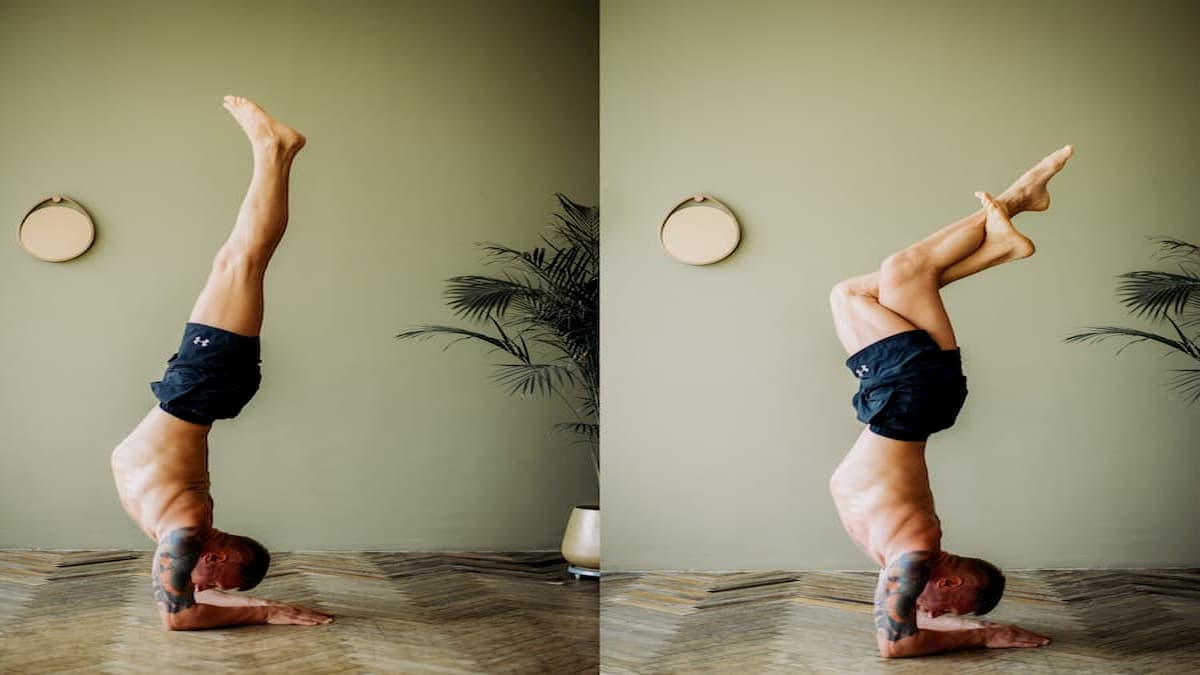Introduction
Pincha Mayurasana is also known as Feathered Peacock, Forearm Stand, or Elbow Stand. It is one of the most difficult poses to master, yet it gives many benefits to the practitioner. At the same time, she/he should take precautionary measures to avoid hurting herself/himself. Hence one should have the right understanding of this yoga posture.
If you are searching for answers to one or more of the questions below, or if you would like to know everything about Feathered Peacock, you have come to the right place. This article tries to answer these queries.
What is the meaning of Pincha Mayurasana?
How to do Feathered Peacock Pose step by step?
What are the benefits of the Forearm Stand?
Pincha Mayurasana Information
| Pose Name | Pincha Mayurasana |
| Sanskrit Name | पिञ्छमयूरासन |
| IAST | Piñchamayūrāsana |
| English Name | Feathered Peacock Pose |
| Origin | Modern |
| Difficulty Level | Hard |
| Type | Inverted Pose |
| Group | Mayurasana |
Pincha Mayurasana Meaning
In Sanskrit, पिञ्छ (piñcha) means feather. मयूर (mayūra) means peacock and आसन (āsana) is a yoga position. Hence it is a yoga pose that resembles a peacock with its feathers up. The legs resemble the feathers while the forearms look like the feet of the peacock. Therefore this yoga pose gets the name Feather Peacock Pose.
It is also known as Picchamayūrāsana (पिच्छमयूरासन). Piccha and piñcha are synonyms in Sanskrit.
Pincha Mayurasana Procedure
Forearm Stand Precautions and Contraindications
People having health conditions like shoulder or elbow issues, uncontrolled High Blood Pressure, Cardiac issues, Spinal issues, Osteoarthritis, Rheumatoid Arthritis, and Osteoporosis should consult their doctor before taking this practice.
Moreover, Pregnant women should avoid the practice of Feathered Peacock.
Pincha Mayurasana Steps
Let us see how to do Feathered Peacock step by step.
Step 1
Sit in Vajrasana. Take a couple of deep breaths.
Step 2
Come forward and place the palms on the floor so that your upper legs and arms are vertical and the body is horizontal.
Step 3
Raise the buttocks and hip to assume the downward-facing Facing Dog. Now lower the upper body and place the forearms on the floor. Then raise one leg. Bend the raised knee and fold that leg. Simultaneously raise the other leg. While the second leg is up, unbend and raise the first leg too. Now the total body is vertical except the forearms. The weight of the body should be on the forearms. This is the final position.
Step 4
Keep the final position as long as it is comfortable. To release the position, bend one knee first. Then lower the buttock, and bring down the other leg to the floor. At the same time, bring down the folded leg. Assume Downward Facing Dog and then Vajrasana.
Forearm Stand Duration
Initially, a duration of thirty seconds is enough. Slowly it can be increased to two to three minutes.
Pincha Mayurasana Sequence
Feathered Peacock Preparatory Poses
To master the Forearm Stand, the mastery of the following poses is necessary.
Forearm Stand Follow Up Poses
Immediately after doing Feathered Peacock, one should assume Matsyasana and then Shavasana.
Pincha Mayurasana Variations
Ardha Pincha Mayurasana or Half-Feathered Peacock
It is a lighter version of the Forearm Stand. In this version, one leg is lifted vertically and the other leg is on the floor. While doing this variation, the change of legs is mandatory. In other words, after performing with one leg up, one should repeat the pose with the other leg up too. A beginner may start with this lighter version before attempting the complete version.
Beginners Tips
Beginners will find it difficult to master this pose. Until getting mastery, a beginner may practice this posture near a wall. He may place the legs near the wall. By doing this, one may avoid a fall. Moreover, balancing will be easy by placing the leg on the wall.
Pincha Mayurasana Benefits
The benefits of Feathered Peacock Pose are as follows.
- The Forearm Stand is a very good remedy for Varicose Veins. It relaxes the veins and removes the stress of the veins and lower parts of the body.
- Regular practice prevents high blood pressure and cardiac issues.
- It strengthens the muscles of the stomach, thigh, arms, elbows, and shoulder joints. Also, it improves the flexibility of the joints of arms, legs, hips, and spine.
- Forearm Stand improves the functions of the endocrine system.
- Like Shirshasana, this yoga pose helps to maintain celibacy. Additionally, it improves conditions like untimely discharge and weak erection.
- The forearm Stand is a very good posture before practicing Pranayama and Meditation. Also, it activates Sahasrara Chakra and hence helps in Kundalini Yoga.
